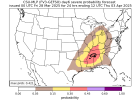April 4, 1974…AND … WEDNESDAY
April 27, 2011….. WEDNESDAY
March 21, 1932….. Monday
February 19-20, 1884….. Tuesday…….. AND WEDNESDAY
While these are big outbreaks that take place on a Wednesday, this info can lend to biases and cause people to think that Wednesday is somehow cursed, and big outbreaks ONLY happen on Wednesday. Be careful. If you were to take all of the outbreaks and sequences as far back as possible, and total how many tornadoes of each intensity occurred on each of the 7 days, I wonder if people would still feel the same about Wednesday?? Lol
I will say this again: whatever rules, biases, and prejudices people may have about the weather because of the last few decades should be thrown out now. The earth is going to increasingly continue to do things it has not done before, in places it has not before, etc.
Just saying…….




